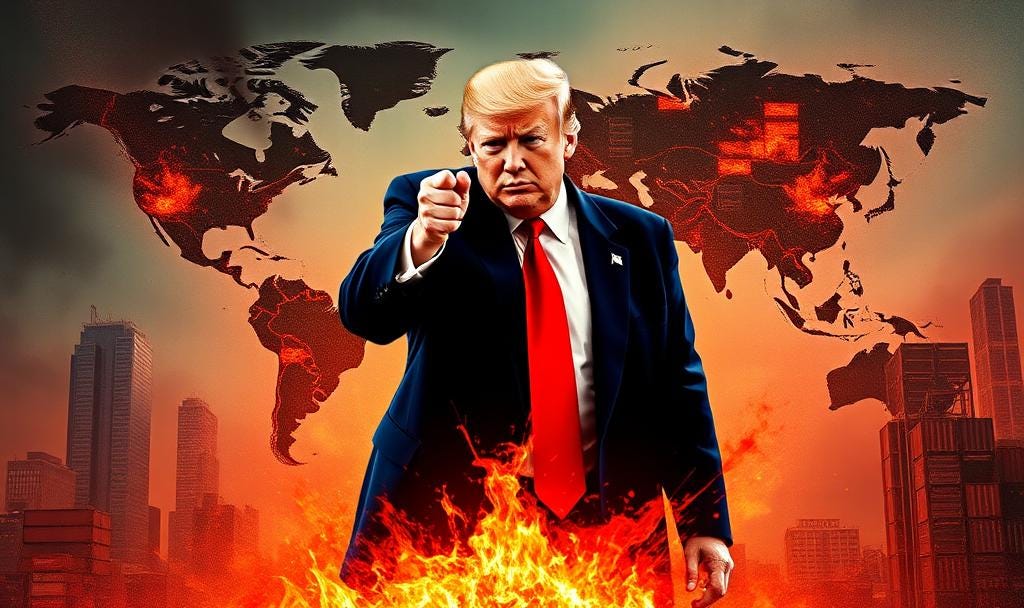Trump’s Tariff Escalation Sparks Global Trade War, Market Chaos, and Economic Uncertainty
President Donald Trump has intensified his trade war with China, announcing a dramatic increase in tariffs on Chinese imports to 125%, effective immediately. The move, unveiled on Wednesday, April 9, comes amid escalating tensions between the world’s two largest economies and retaliatory measures from China, which raised its tariffs on U.S. goods to 84%. While Trump has temporarily paused tariffs for 90 days for over 75 other trading partners, the decision has sent shockwaves through global markets and raised fears of a looming recession.
The sweeping tariffs, which include a baseline 10% levy on all imports and higher rates targeting specific countries, have disrupted supply chains and sparked criticism from world leaders, economists, and business executives. The White House argues that the measures are necessary to correct trade imbalances and bolster American manufacturing. Still, critics warn they could backfire by raising consumer prices and slowing economic growth.
A Global Trade War Unfolds
China has been the primary target of Trump’s tariff strategy. The new 125% tariff on Chinese goods follows a series of increases earlier this year, including a 34% hike just last week. Beijing responded swiftly by raising its tariffs on U.S. products to 84%, targeting key sectors such as energy and agriculture.
“The history and facts demonstrate that the U.S.’s tariff increases will not resolve its issues,” China’s Commerce Ministry said in a statement. “Rather, it will cause significant volatility in financial markets, escalate inflation pressures in the U.S., and undermine the American industrial foundation.”
The European Union has also announced countermeasures, imposing 25% tariffs on U.S. imports in response to Trump’s duties on European goods. Canada and other U.S. allies have followed suit with their retaliatory actions.
Economic Fallout: Markets React
The tariffs have had an immediate impact on global financial markets. Over the past week, U.S. stock markets experienced their worst two-day decline in history, losing $6.6 trillion in value before partially rebounding on Tuesday. On Wednesday, however, stocks fell again as investors grappled with the implications of Trump’s latest tariff hikes.
The S&P 500 dropped into bear market territory—a decline of more than 20% from recent highs—while the Nasdaq plunged by over 9%. Analysts at JPMorgan Chase have warned that the tariffs could push the U.S. economy into recession by the end of the year.
“The likelihood of stagflation is 100%,” said Brian Bethune, an economics professor at Boston College. “We are entering a period where inflation will rise due to higher import costs while economic growth slows.”
Consumers and Businesses Feel the Pinch
The tariffs are expected to raise prices for American consumers, with the nonpartisan Tax Foundation estimating an average annual cost increase of $2,100 per household. Retailers like Walmart have already adjusted their earnings forecasts for higher import costs.
“While we can’t predict everything that will happen, we understand our priorities and purpose,” Walmart CEO Doug McMillon said during an investor meeting in Dallas. “We are committed to keeping prices as low as possible while managing our inventory and expenses effectively.”
Manufacturers reliant on imported materials are also bracing for higher costs. Tesla CEO Elon Musk has criticized the tariffs for disrupting supply chains and raising production expenses for electric vehicles.
World Leaders Condemn Tariff Strategy
Trump’s tariff escalation has drawn sharp criticism from world leaders and international organizations. European Commission President Ursula von der Leyen described the tariffs as a “major blow” to global trade and warned of “spiraling uncertainty” for businesses and consumers worldwide.
French President Emmanuel Macron called Trump’s actions “deeply unfortunate” and pledged to support affected European industries. Meanwhile, Canadian Prime Minister Mark Carney accused Trump of instigating a trade crisis but vowed that Canada would respond decisively.
Economists have also questioned the rationale behind Trump’s tariff calculations, which are based on trade deficits rather than established economic principles. “It’s fundamentally flawed economics,” said Marcus Noland, executive vice president at the Peterson Institute for International Economics. “Trade deficits are not inherently problematic.”
Temporary Relief for Some Nations
In a surprising move, Trump announced a 90-day suspension of tariffs for over 75 trading partners that refrained from retaliating against his initial measures. During this period, these nations will face a reduced overall tariff rate of 10%. However, this pause does not apply to China or other countries that have imposed countermeasures.
“This is fantastic news for the market,” said Tom Brigham, chief investment strategist at Tangle Wealth Management in Houston. “But uncertainty remains regarding what will happen after the 90 days.”
What’s Next?
As global trade tensions escalate, economists warn that further tariff increases could deepen economic instability and push more countries into recession. Analysts at UBS predict that China’s economic growth rate could drop to just 4% if current trends continue.
Domestically, businesses are urging the Trump administration to reconsider its approach. Jamie Dimon, CEO of JPMorgan Chase, described the tariffs as a “high-risk strategy” that could erode consumer confidence and disrupt capital flows.
“The sooner this matter is resolved, the better,” Dimon wrote in his annual letter to shareholders. “Some of the adverse effects could compound over time and become difficult to reverse.”
The global economy remains on edge as nations navigate an uncertain trade landscape shaped by Trump’s aggressive policies. Whether these measures will achieve their intended goals or lead to long-term economic harm remains to be seen.



